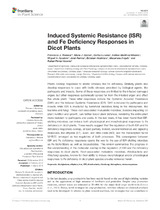Mostrar el registro sencillo del ítem
Induced Systemic Resistance (ISR) and Fe Deficiency Responses in Dicot Plants
| dc.contributor.author | Romera, Francisco Javier | |
| dc.contributor.author | García, María José | |
| dc.contributor.author | Lucena, Carlos | |
| dc.contributor.author | Martínez-Medina, Ainhoa | |
| dc.contributor.author | Aparicio Jiménez, Miguel Ángel | |
| dc.contributor.author | Ramos, José | |
| dc.contributor.author | Alcántara Vara, Esteban | |
| dc.contributor.author | Angulo, Macarena | |
| dc.contributor.author | Pérez-Vicente, Rafael | |
| dc.date.accessioned | 2019-06-03T07:29:01Z | |
| dc.date.available | 2019-06-03T07:29:01Z | |
| dc.date.issued | 2019 | |
| dc.identifier.uri | http://hdl.handle.net/10396/18686 | |
| dc.description.abstract | Plants develop responses to abiotic stresses, like Fe deficiency. Similarly, plants also develop responses to cope with biotic stresses provoked by biological agents, like pathogens and insects. Some of these responses are limited to the infested damaged organ, but other responses systemically spread far from the infested organ and affect the whole plant. These latter responses include the Systemic Acquired Resistance (SAR) and the Induced Systemic Resistance (ISR). SAR is induced by pathogens and insects while ISR is mediated by beneficial microbes living in the rhizosphere, like bacteria and fungi. These root-associated mutualistic microbes, besides impacting on plant nutrition and growth, can further boost plant defenses, rendering the entire plant more resistant to pathogens and pests. In the last years, it has been found that ISReliciting microbes can induce both physiological and morphological responses to Fe deficiency in dicot plants. These results suggest that the regulation of both ISR and Fe deficiency responses overlap, at least partially. Indeed, several hormones and signaling molecules, like ethylene (ET), auxin, and nitric oxide (NO), and the transcription factor MYB72, emerged as key regulators of both processes. This convergence between ISR and Fe deficiency responses opens the way to the use of ISR-eliciting microbes as Fe biofertilizers as well as biopesticides. This review summarizes the progress in the understanding of the molecular overlap in the regulation of ISR and Fe deficiency responses in dicot plants. Root-associated mutualistic microbes, rhizobacteria and rhizofungi species, known for their ability to induce morphological and/or physiological responses to Fe deficiency in dicot plant species are also reviewed herein | es_ES |
| dc.format.mimetype | application/pdf | es_ES |
| dc.language.iso | eng | es_ES |
| dc.publisher | Frontiersin.org | es_ES |
| dc.rights | https://creativecommons.org/licenses/by/4.0/ | es_ES |
| dc.source | Frontiers in Plant Science 10, 287 (2019) | es_ES |
| dc.subject | Dicotyledons | es_ES |
| dc.subject | Ethylene | es_ES |
| dc.subject | Iron | es_ES |
| dc.subject | ISR | es_ES |
| dc.subject | Rhizobacteria | es_ES |
| dc.subject | Rhizofungi | es_ES |
| dc.subject | Rhizosphere | es_ES |
| dc.subject | Stress responses | es_ES |
| dc.title | Induced Systemic Resistance (ISR) and Fe Deficiency Responses in Dicot Plants | es_ES |
| dc.type | info:eu-repo/semantics/article | es_ES |
| dc.relation.publisherversion | https://doi.org/10.3389/fpls.2019.00287 | es_ES |
| dc.relation.projectID | Junta de Andalucía. AGR-115 | es_ES |
| dc.relation.projectID | Junta de Andalucía. BIO-159 | es_ES |
| dc.relation.projectID | Junta de Andalucía. BIO-202 | es_ES |
| dc.rights.accessRights | info:eu-repo/semantics/openAccess | es_ES |

